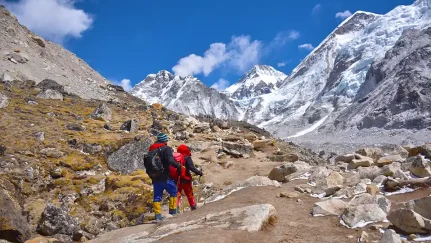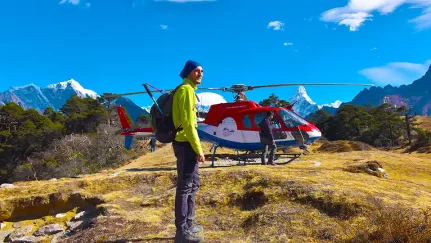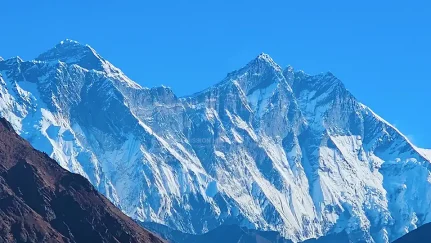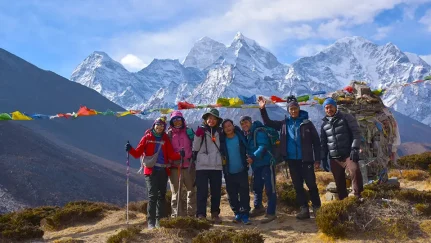Why Choose an Everest Base Camp Guided Trek?
Everest Base Camp is one of the most famous trekking routes in the world. It takes you through beautiful mountains, small villages, and high-altitude trails. But trekking to Everest Base Camp is not easy. The journey is long, the altitude is high, and the weather can change quickly. This is why many people choose an Everest Base Camp Guided Trek instead of going alone.
- Safety and Support
A guided trek means you will have an experienced guide with you at all times. The guide knows the trails, the weather, and how to handle emergencies. If you feel sick or tired, the guide will help you. They also carry oxygen and first aid in case of altitude sickness. This makes the trek much safer, especially for first-time trekkers.
- No Need to Worry About Logistics
Planning an Everest Base Camp Guided Trek by yourself takes a lot of work. You need to book flights, find places to sleep, and arrange food. With a guided trek, everything is planned for you. The company arranges your flights to Lukla, books your lodges, and makes sure you get meals along the way. This lets you focus on enjoying the trek instead of worrying about the details.
- Experienced Guides Share Knowledge
Trekking with a guide is not just about safety. It is also about learning. Guides know a lot about the Everest region, the culture, and the history of the mountains. They can tell you stories about Sherpa people, Buddhist traditions, and how Mount Everest was first climbed. This makes the trek more interesting and meaningful.
- Easier to Handle Altitude and Pace
The high altitude at Everest Base Camp can make people feel weak or sick. A good guide will make sure you walk at the right pace and take enough rest days to adjust. This helps prevent altitude sickness. If you go alone, you might push too hard and get sick. With a guided trek, you follow a plan that helps your body adjust to the thin air.
- Meet New Friends and Enjoy the Trek More
When you join an Everest Base Camp Guided Trek, you will likely be in a group with other trekkers. This means you can make new friends, share experiences, and support each other along the way. Trekking in a group also makes long walking days feel easier because you have company.
Is a Guided Trek Worth It?
Some people like trekking alone, but it can be risky and stressful, especially for beginners. A guided trek gives you safety, comfort, and knowledge. It also saves time because everything is planned for you. If you want to enjoy the beauty of the Himalayas without worry, then an Everest Base Camp Guided Trek is the best choice.
Best Time for an Everest Base Camp Guided Trek
Trekking to Everest Base Camp is a dream for many people. But choosing the right time to go is very important. The weather in the Himalayas can change fast, and the wrong season can make the trek difficult. If you plan an Everest Base Camp Guided Trek, knowing the best seasons will help you have a safe and enjoyable journey.
Spring (March to May) – One of the Best Seasons
Spring is one of the best times for an Everest Base Camp Guided Trek. The weather is warmer, and the skies are mostly clear. The trails are filled with blooming rhododendron flowers, making the trek more beautiful. This season is also popular for climbers trying to reach the top of Mount Everest. You might see many colorful tents at base camp as climbers prepare for their journey.
During spring, the daytime temperatures are comfortable, usually between 10°C to 15°C at lower altitudes. However, at night, it can still get very cold, especially near base camp. The chances of heavy snowfall or rain are lower in this season, making it a good time for trekking.
Autumn (September to November) – Another Great Time
Autumn is another great season for an Everest Base Camp Guided Trek. The summer monsoon season ends, so the skies are clear, and the views of the mountains are sharp. The trails are dry, which makes walking easier. Many trekkers choose autumn because the weather is stable, and the temperatures are just right for trekking.
The daytime temperatures are similar to spring, between 10°C to 15°C in lower areas. At higher altitudes, it gets colder, but not as extreme as winter. Since the weather is nice, this is one of the busiest trekking seasons. If you prefer quieter trails, you might want to start your trek in early September or late November.
Winter (December to February) – Cold but Peaceful
Winter is the coldest time for an Everest Base Camp Guided Trek. The temperatures can drop below -20°C at base camp. The trails are covered in snow, and some parts can be slippery. However, if you like peace and do not mind the cold, this season can be a great choice. There are fewer trekkers, and the mountains look magical with fresh snow.
One big challenge of winter trekking is the risk of flight delays to Lukla due to bad weather. If you plan to trek in winter, you need to pack extra warm clothes and be ready for very cold nights.
Summer (June to August) – Not the Best Time
Summer is the monsoon season in Nepal. This means a lot of rain, muddy trails, and leeches in the lower regions. The mountains are often covered by clouds, so you may not get clear views. Because of these conditions, summer is not the best time for an Everest Base Camp Guided Trek. However, some trekkers still go during this season because it is less crowded.
Which Season is Best for You?
If you want the best weather and beautiful views, spring and autumn are the best times for an Everest Base Camp Guided Trek. Winter is good if you want fewer crowds and do not mind the cold. Summer is the least popular due to heavy rain and cloudy skies. Choosing the right season will help you enjoy your trek and have an amazing adventure.
Everest Base Camp Trek Itinerary: A Day-by-Day Breakdown
An Everest Base Camp Guided Trek takes about 12 to 14 days. Each day, you will walk for several hours through beautiful mountain trails, small villages, and high-altitude landscapes. A guided trek follows a planned schedule to help trekkers adjust to the thin air and complete the journey safely. Here is a simple breakdown of the trek itinerary.
Day 1: Flight to Lukla and Trek to Phakding
The journey starts with a short but exciting flight from Kathmandu to Lukla. Lukla is a small town with a famous mountain airport. After landing, you will start trekking to Phakding, which is about a 3-hour walk. The trail is mostly downhill and passes through green forests and small villages.
Day 2: Trek to Namche Bazaar
The trek to Namche Bazaar is tough but beautiful. It takes about 6 to 7 hours and includes crossing high suspension bridges and walking along the Dudh Koshi River. Namche Bazaar is a lively town with shops, bakeries, and great mountain views.
Day 3: Acclimatization Day in Namche Bazaar
Since Namche Bazaar is at a high altitude, this day is for rest and adjustment. You can take a short hike to Everest View Hotel to see Mount Everest for the first time. Exploring Namche’s markets and museums is also a good way to spend the day.
Day 4: Trek to Tengboche
The trek from Namche to Tengboche takes about 5 to 6 hours. Tengboche is home to a famous Buddhist monastery with a stunning view of Everest and other peaks. If you arrive early, you can watch the monks praying in the evening.
Day 5: Trek to Dingboche
The trail to Dingboche is mostly uphill and takes about 6 hours. As you go higher, trees disappear, and the landscape becomes more open with rocky paths. Dingboche is a quiet village where trekkers rest before going to higher altitudes.
Day 6: Acclimatization Day in Dingboche
This is another rest day to help your body adjust to the high altitude. Many trekkers take a short hike to Nangkartshang Peak for breathtaking views of the Himalayas.
Day 7: Trek to Lobuche
The trek to Lobuche is around 5 to 6 hours. You will pass through Thukla Pass, where there are memorials for climbers who lost their lives on Everest. The air gets thinner, so walking becomes harder, but the views keep getting better.
Day 8: Trek to Everest Base Camp and Back to Gorak Shep
This is the most exciting day of the Everest Base Camp Guided Trek. After walking for a few hours, you will reach Everest Base Camp. You will see colorful tents of climbers preparing to climb Everest. After spending some time at base camp, you will return to Gorak Shep for the night.
Day 9: Hike to Kala Patthar and Trek to Pheriche
Early in the morning, you will hike to Kala Patthar, the best place to see sunrise over Mount Everest. After taking pictures, you will walk back down to Pheriche, a small village at a lower altitude.
Day 10: Trek to Namche Bazaar
The trail back to Namche is much easier because you are going downhill. You will pass familiar villages and forests before reaching Namche.
Day 11: Trek to Lukla
The last walking day of the Everest Base Camp Guided Trek is from Namche to Lukla. This takes about 7 hours and is mostly downhill. You can celebrate the successful trek with your group in Lukla.
Day 12: Flight to Kathmandu
Early in the morning, you will take a flight back to Kathmandu, ending your Everest Base Camp Guided Trek. This is the time to relax, enjoy good food, and look back on the amazing adventure.
Essential Gear for Your Everest Base Camp Guided Trek
Packing the right gear is very important for an Everest Base Camp Guided Trek. The weather in the Himalayas changes a lot, and you need to be ready for cold temperatures, strong winds, and rough trails. Carrying too much can make trekking hard, but missing something important can make it even harder. Here is a simple guide to the must-have equipment for your trek.
- Trekking Clothes
Wearing the right clothes will keep you warm and comfortable. Layering is the best way to dress because it helps you adjust to different temperatures.
- Base Layer: A thermal top and bottom to keep your body warm
- Middle Layer: A fleece or down jacket for extra warmth
- Outer Layer: A waterproof and windproof jacket and pants to protect against rain and snow
- Trekking Pants and Shirts: Lightweight and breathable for daytime hiking
- Gloves and Hat: Warm gloves for cold weather and a sun hat for protection from the sun
- Trekking Boots and Socks
A good pair of trekking boots is one of the most important things for an Everest Base Camp Guided Trek. Make sure they are strong, waterproof, and comfortable. It is best to wear them before the trek to avoid blisters.
You should also bring:
- Woolen socks: Keep your feet warm at night
- Liner socks: Help prevent blisters
- Gaiters: Keep snow and dust out of your boots
- Sleeping Bag and Trekking Poles
- Sleeping Bag: Tea houses provide blankets, but a warm sleeping bag (rated for -10°C to -20°C) is better for the cold nights
- Trekking Poles: These help with balance on steep trails and reduce pressure on your knees
- Backpack and Duffel Bag
- Daypack (30-40L): A small backpack for carrying your daily essentials like water, snacks, and a camera
- Duffel Bag: Carried by porters to hold your clothes and other items
- Water Bottles and Purification
Staying hydrated is very important for high-altitude trekking. You should bring:
- Two reusable water bottles (1L each)
- Water purification tablets or a water filter to clean water from local sources
- First Aid Kit and Medicine
- Altitude sickness pills (like Diamox)
- Painkillers for headaches
- Bandages and blister plasters
- Lip balm and sunscreen to protect from sunburn
- Snacks and Energy Boosters
Trekking uses a lot of energy, so carrying snacks is a good idea. Some good options are:
- Energy bars and nuts
- Chocolate and dried fruits
- Electrolyte powder to mix with water
- Headlamp and Other Accessories
- Headlamp with extra batteries for dark trails and tea house rooms
- Sunglasses to protect against snow glare
- Camera or phone to capture beautiful views
Packing smart will make your Everest Base Camp Guided Trek much easier. Having the right gear will help you stay safe, warm, and comfortable so you can enjoy your adventure in the Himalayas.
How to Choose the Best Everest Base Camp Guided Trek Package
Planning an Everest Base Camp Guided Trek is exciting, but choosing the right trekking company is very important. A good company will keep you safe, provide experienced guides, and make sure you have a great experience. There are many trekking companies, so it can be hard to decide which one to pick. Here are some simple tips to help you choose the best Everest Base Camp Guided Trek package.
- Check the Company’s Reputation
A good trekking company will have a strong reputation. Look for reviews and ratings from past trekkers. You can check travel websites, trekking forums, and social media pages. If many people have shared good experiences, it means the company is trustworthy.
- Look at the Itinerary and Services
Different companies offer different trek packages. Some might have a longer itinerary with more rest days, which is better for acclimatization. Others might have shorter schedules that can be more challenging. Check what is included in the package, such as:
- Accommodation in tea houses
- Meals during the trek
- Domestic flights (Kathmandu to Lukla and back)
- Guide and porter services
- Trekking permits
- Check the Experience of Guides
A well-trained and experienced guide makes a big difference in your trek. They should have good knowledge of the trails, weather, and altitude sickness. A guide who speaks your language can also help you understand the local culture and communicate with tea house owners.
- Compare Prices but Avoid the Cheapest Option
The price of an Everest Base Camp Guided Trek varies depending on the company and services. Some companies offer very cheap packages, but they might not provide good food, experienced guides, or proper safety measures. It is better to pay a little more for a reliable and safe experience.
- Ask About Group Size
Some companies take large groups, while others keep them small. Smaller groups are better because you get more personal attention from the guide. In big groups, it can be harder to keep pace, and there might be long waits at tea houses.
- Check Safety Measures
The Himalayas can be unpredictable, so safety is very important. A good company will:
- Have guides trained in first aid and altitude sickness treatment
- Carry oxygen tanks for emergencies
- Have a proper plan for helicopter evacuation if needed
- Look for Responsible Trekking Companies
- Choose a company that supports responsible tourism. This means they:
- Pay guides and porters fairly
- Use eco-friendly practices like reducing plastic waste
- Support local communities
- Ask About Booking and Cancellation Policies
Before booking, check the cancellation and refund policy. If flights to Lukla get canceled due to bad weather, you should know what options the company provides.
Choosing the best Everest Base Camp Guided Trek package takes time, but it is worth the effort. A good trekking company will make sure your journey is safe, comfortable, and unforgettable. Take your time to compare different options, read reviews, and ask questions before making your final decision.














